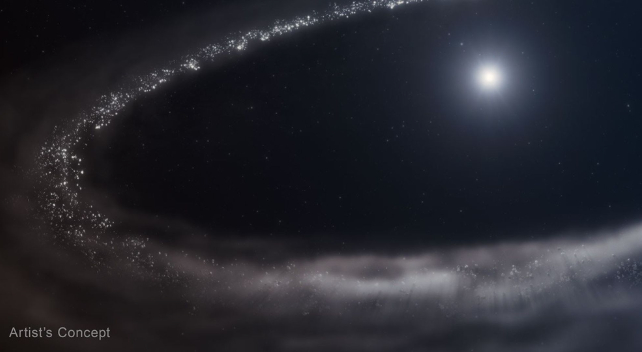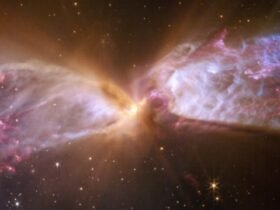For decades it was thought that water was prevalent in the outer reaches of the Solar System early in its history, with comets and asteroids delivering moisture to Earth and the inner planets during the Late Heavy Bombardment period around 4 billion years ago.
An abundance of ice in places like the Kuiper Belt – the ring of ‘iceteroids’ in the outer Solar System – supports the idea. However, the hypothesis could not be tested until it became possible to study extrasolar systems in the early stages of formation.
Thanks to the JWST, scientists finally have hard evidence that this theory is correct. According to a recent study led by researchers from Johns Hopkins University (JHU), the space telescope detected water ice in the debris disk that orbits HD 181327, a Sun-like star 155 light-years from Earth.
Just 23 million years old, this system is quite young compared to the Solar System (4.6 billion years and counting!). As a result, the star is surrounded by a protoplanetary disk that has not yet coalesced to form a system of planets. Studying stars this young allows astronomers to observe a system still in the early stages of formation.
As Chen Xie, an assistant research scientist at JHU and the study’s lead author, said in a recent NASA press release:
“Webb unambiguously detected not just water ice, but crystalline water ice, which is also found in locations like Saturn’s rings and icy bodies in our Solar System’s Kuiper Belt. The presence of water ice helps facilitate planet formation. Icy materials may also ultimately be ‘delivered’ to terrestrial planets that may form over a couple hundred million years in systems like this.”
The researchers observed HD 181327 using JWST’s near-infrared spectrograph (NIRSpec), which revealed the telltale chemical traces of water in the outer reaches of the system’s debris disk.
As predicted, most of the system’s water ice was found in the outer debris ring, accounting for over 20 percent of its mass. Like the Kuiper Belt, the water is in the form of ‘dirty snowballs‘ – ice combined with fine dust particles.
The closer to the star the researchers looked, the less water they found. Just 8 percent of the material half way in from the disk’s edge consists of ice, where virtually none was detected towards the center of the system. This is likely due to vaporization from the star’s ultraviolet radiation, though it’s also possible that a sizeable amount of water is locked up in rocks and planetesimals.
Since water ice heavily influences the formation of planets around young stars, the results present new opportunities for researchers to study the processes governing solar system development. They also confirm what NASA’s Spitzer Space Telescope hinted at when it observed this system in 2008.
“When I was a graduate student 25 years ago, my advisor told me there should be ice in debris disks, but prior to Webb, we didn’t have instruments sensitive enough to make these observations,” says Christine Chen, an associate astronomer at the Space Telescope Science Institute (STScI) and co-author on the study.
“What’s most striking is that this data looks similar to the telescope’s other recent observations of Kuiper Belt objects in our own Solar System.”
Webb’s observations also revealed a wide, dust-free gap between the star and its debris disk. Farther from the star, the debris disk looks similar to the Kuiper Belt, which is populated by countless dirty snowballs and minor planets. In addition, collisions still take place in the Kuiper Belt, which the team noticed about HD 181327 as well.

“HD 181327 is a very active system,” says Chen. “There are regular, ongoing collisions in its debris disk. When those icy bodies collide, they release tiny particles of dusty water ice that are perfectly sized for Webb to detect.”
With these observations under their belt, astronomers will continue to search for water ice and debris disks to observe closely using JWST and other next-generation telescopes, some of which will launch soon.
Studying these actively forming planetary systems will inform planetary formation models and shed new light on how our Solar System came to be.
The team’s results were published in the journal Nature.













Leave a Reply